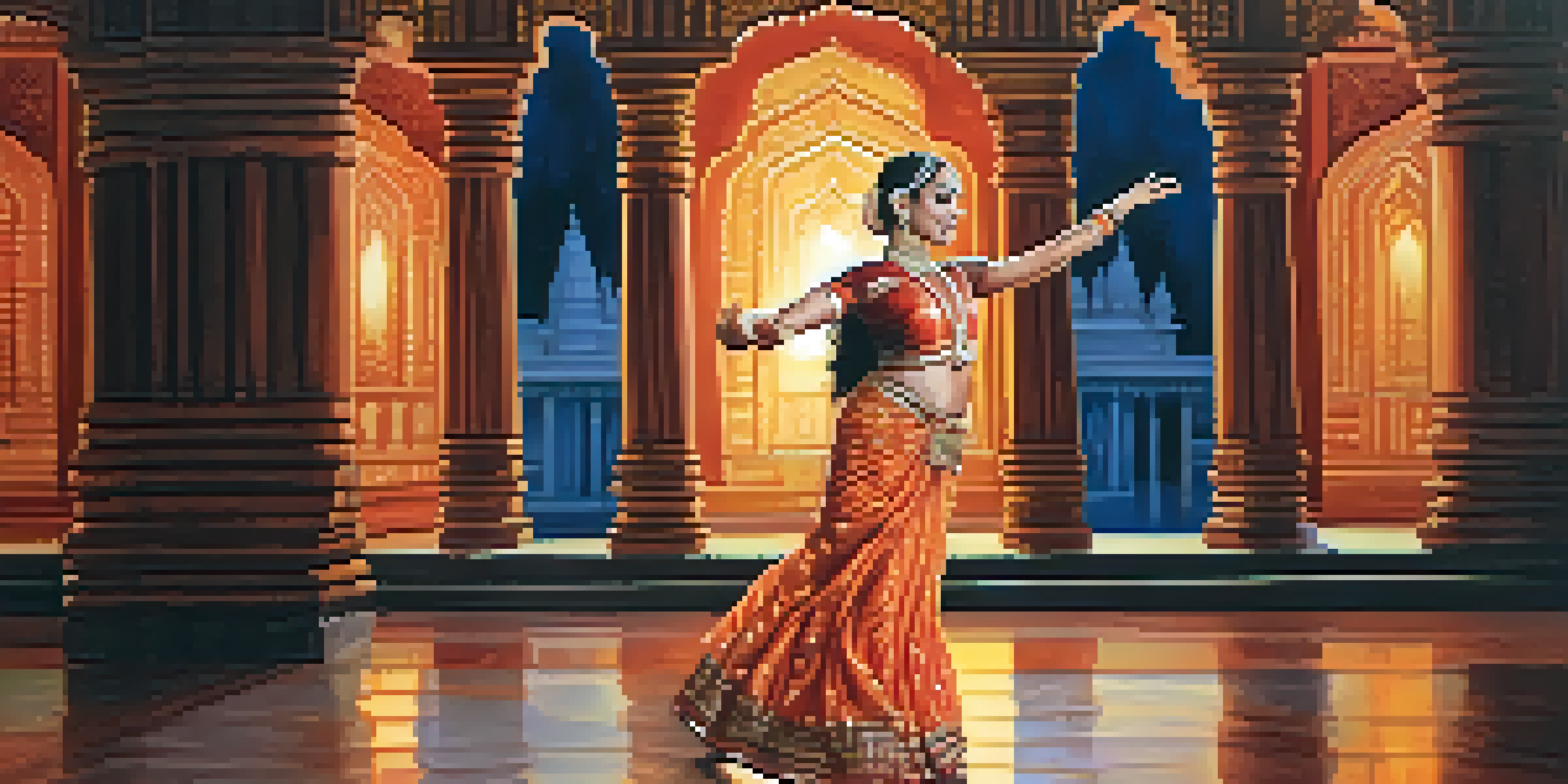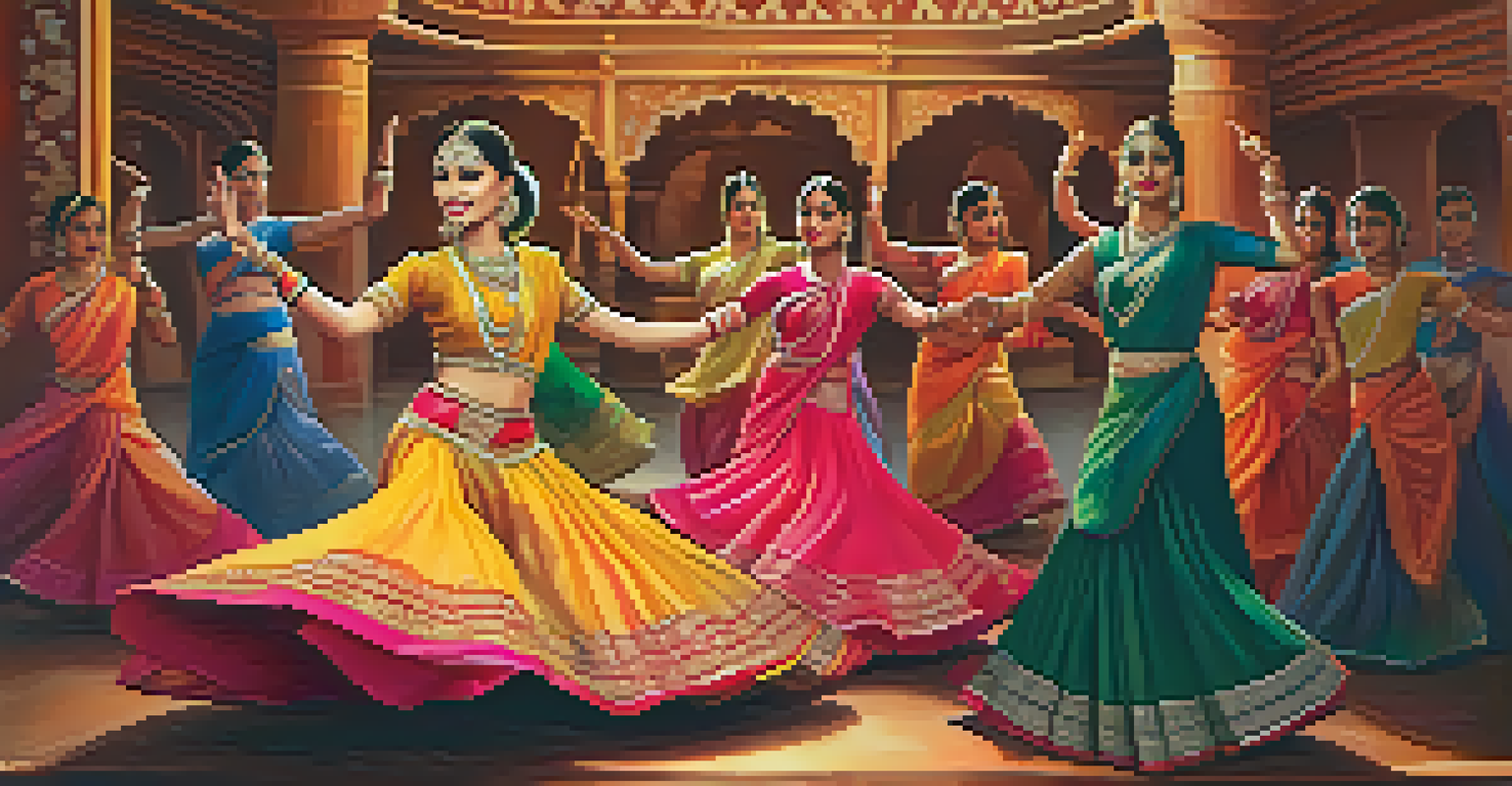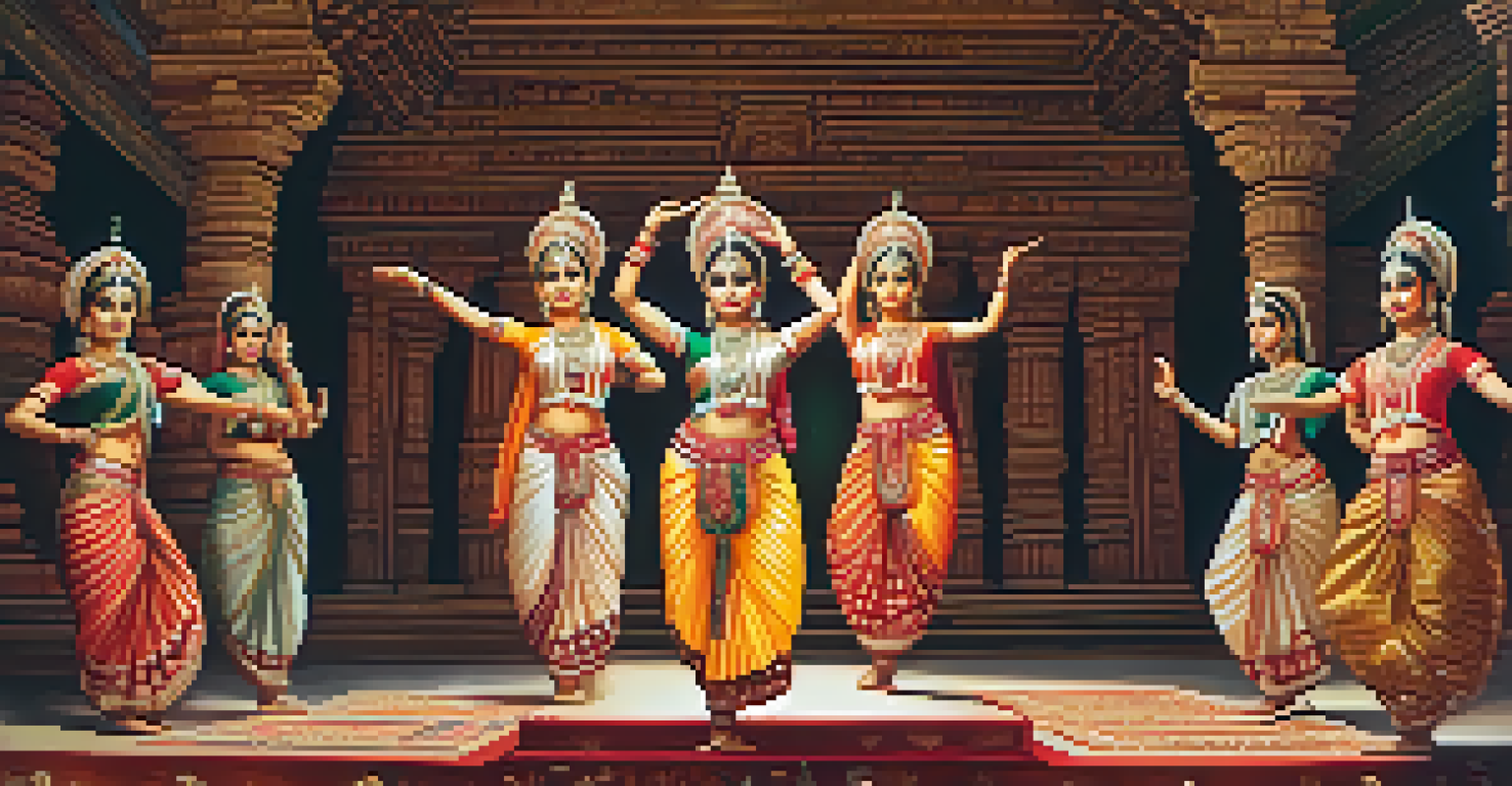Exploring Classical Dances of India: A Traveler's Guide

Introduction to India's Classical Dance Heritage
India boasts a rich tapestry of classical dance forms, each with its unique style and history. These dances are not just performances; they are expressions of spirituality, culture, and storytelling. From Bharatanatyam in Tamil Nadu to Kathak in North India, every dance has its roots deep in the traditions of the land.
Dance is the hidden language of the soul.
As a traveler, immersing yourself in these art forms can enhance your understanding of India's diverse cultural landscape. Each region showcases its own dance forms, often tied to local myths and rituals. So, whether you're visiting a temple performance or a grand festival, the experience can be deeply enriching.
This guide will explore various classical dance forms, providing insights into their origins, techniques, and where to see them live. By understanding these dances, you'll appreciate not just the art itself but also the stories and emotions they convey.
Bharatanatyam: The Dance of Tamil Nadu
Bharatanatyam is one of the oldest classical dance forms of India, originating in Tamil Nadu. Known for its graceful movements and expressive storytelling, this dance often portrays themes from Hindu mythology. It combines intricate footwork, hand gestures (mudras), and facial expressions to convey emotions.

Traditionally performed by temple dancers called Devadasis, Bharatanatyam has evolved over centuries. Today, it is celebrated worldwide, with performances often held in cultural festivals and dance schools. If you're in Tamil Nadu, don’t miss the chance to witness this mesmerizing performance in its natural setting.
Diverse Indian Dance Forms
India's classical dance heritage showcases a rich variety of styles, each reflecting unique cultural narratives and spiritual themes.
To fully appreciate Bharatanatyam, consider attending a workshop or a lecture demonstration. Understanding the nuances of the dance will deepen your connection to the performance and the culture it represents.
Kathak: The Storytelling Dance of North India
Kathak, which translates to 'story', is a classical dance form that originated in North India. It is characterized by intricate footwork, spins, and expressive gestures. Traditionally, Kathak dancers narrated stories from Indian epics like the Ramayana and Mahabharata through their movements.
The dance is a poem of which each movement is a word.
One of the unique features of Kathak is its fusion of Hindu and Mughal influences, making it rich in diversity. The dance is often performed as a duet, where the dancer engages with the accompanying musician, creating a dynamic interplay of rhythm and expression. This makes each performance a unique experience.
For travelers, catching a live Kathak performance in cities like Lucknow or Jaipur can be a highlight. Attending workshops can also provide insights into the history and techniques that make Kathak so enchanting.
Odissi: The Graceful Dance of Odisha
Odissi is one of the oldest surviving dance forms of India, originating from the temples of Odisha. Known for its fluid movements and intricate poses, Odissi is often performed in a group, showcasing both solo and ensemble pieces. The dance is deeply spiritual, often depicting devotion to Lord Jagannath.
A hallmark of Odissi is its use of 'tribhanga', a three-bend posture that embodies grace and poise. The dancers often wear elaborate costumes and jewelry that enhance the visual appeal of the performance. This makes Odissi not just a dance but a visual feast as well.
Cultural Immersion through Dance
Attending live performances and workshops can deepen travelers' understanding and appreciation of India's vibrant cultural landscape.
If you're visiting Odisha, explore the local dance festivals where Odissi is performed. Engaging with local artists can also provide a deeper appreciation for this beautiful art form and its cultural significance.
K Kathakali: The Theatrical Dance Drama of Kerala
Kathakali is a highly stylized dance-drama known for its elaborate costumes and makeup. Originating from Kerala, this dance form combines storytelling with dramatic expression. The performances often depict tales from Hindu epics, particularly the Ramayana and Mahabharata.
One standout feature of Kathakali is its elaborate face makeup, which signifies the character's role and personality. The performers undergo extensive training to master not just the dance but also the art of expression, making each performance a captivating spectacle.
If you find yourself in Kerala, attending a Kathakali performance is a must. Many cultural centers offer workshops, allowing you to try your hand at this intricate art and gain a deeper understanding of its significance.
Manipuri: The Dance of Grace and Devotion
Manipuri is a classical dance form from the northeastern state of Manipur, known for its graceful movements and serene expressions. It often depicts themes of love and devotion, particularly towards Lord Krishna. The dance is characterized by its fluidity, with dancers often performing in a circular formation.
Unlike some other Indian dance forms, Manipuri is less about vigorous footwork and more about subtle movements that convey emotion. The dancers wear beautiful traditional costumes, which add to the ethereal quality of the performance, making it truly enchanting.
Emotional Storytelling in Dance
Each classical dance form in India conveys profound stories and emotions, often rooted in mythology and local traditions.
To experience Manipuri dance, visit Manipur during local festivals. Engaging with local dance schools can also provide insights into the techniques and cultural heritage of this beautiful art form.
Sattriya: The Dance of Assam
Sattriya is a classical dance form that originated in Assam and is closely tied to the Vaishnavism movement. It is often performed by monks in monasteries, showcasing devotion through expressive movements and musical accompaniment. The dance is characterized by its graceful footwork and intricate hand gestures.
Sattriya is unique as it often incorporates elements of drama and storytelling, similar to other classical forms. With colorful costumes and lively music, Sattriya performances can be both spiritual and entertaining, making it a captivating experience for audiences.

If you're traveling to Assam, look for local performances, especially in Sattriya monasteries. Participating in a workshop can also deepen your understanding of this vibrant dance form and its spiritual significance.
Conclusion: Embracing India Through Dance
Exploring the classical dances of India is like taking a journey through the country's rich cultural heritage. Each dance form offers a unique lens through which to understand the traditions, stories, and spiritual beliefs of the region. As you travel, allow yourself to be swept away by the beauty and depth of these performances.
Engaging with local artists and attending performances can enhance your travel experience, providing insights that go beyond surface-level sightseeing. Whether you find yourself in a grand theater or a small village, the passion and dedication of the dancers will surely resonate with you.
Explore India's Dance Diversity
India's classical dance forms are rich expressions of spirituality and culture, offering unique insights into regional traditions.
So, pack your bags and get ready to embrace the rhythm of India through its classical dances. Each performance you attend will leave you with lasting memories and a deeper appreciation for this vibrant culture.